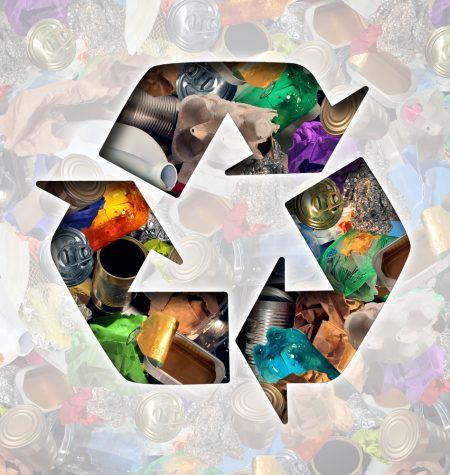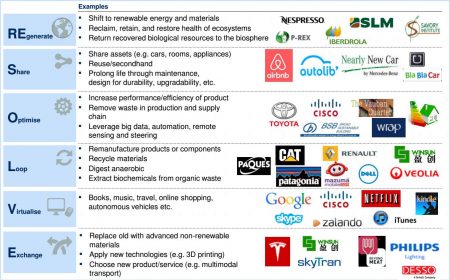July 30, 2016 – What is a circular economy? It is an industrial economy whose material flows lead to 100% recycling and zero pollution. Material flows cover things biological and material. A recent article appearing in the British paper, The Guardian, lists ten things to know about a circular economy. In summary, they are:
- A circular economy goes beyond recycling. It includes repair, reuse and re-manufacturing. The end result is products with longer lifecycles and the reduction in energy use needed to manufacture new things.
- A circular economy decouples economic growth from resource consumption ending the take, make and dispose standard by which we operate today. If we can end the waste and throw away mentality we reduce supply risk and the commensurate volatile shifts in the price of commodities from food to rare earth materials.
- The circular economy isn’t a crackpot or flaky notion. The concept is being seriously debated by academics, governments and business. And Meryl Streep likes it.
- The business case for it could add $1 trillion US to the global economy and 100,000 new jobs in the next five years. based on a Circular Economy 2020 Vision document produced by the European Union. For manufacturers, the report states the reuse of materials would yield $630 billion in annual savings by 2025.
- The circular economy concept is being embraced by large corporations with pilot projects on the go. But small businesses are still in the dark about it. A recent European Union survey of small businesses indicated that almost 50% were unfamiliar with the term.
- A circular economy requires government to enact waste prevention legislation and to create incentives to promote product reuse, repair and re-manufacturing.
- A circular economy changes consumer behaviour. Pay per use, a product-as-service model, could become the standard for most of what we buy with the exception of clothes. That fits with the growing use of services like Uber.
- A circular economy will cause a revolution in education. This goes beyond STEM (Science, Technology, Engineering and Mathematics) subject matter. It includes disciplines such as design and creative thinking. Already this kind of teaching is starting in Australia.
- A circular economy will be disruptive because new business practices will displace old ones. Businesses already testing the new way in pilot projects recognize the level of disruption as a necessary risk because of the larger risks to the planet if circular economic principles are not implemented.
- In the United Kingdom, the current economy is described as 19% circular. Application of pilot projects currently on the go could raise that to 27% by 2020. The impact would mean 137 million tons of materials recycled out of 510 million needed to sustain the economy.
So who in the business world is applying circular economy principles?
Speedo is making swimwear from recycled textile factory scraps.
Ford is taking old floor mats and turning them into engine components, and in partnership with Novelis is recycling much of the aluminum used to build its vehicles.
Eveready is manufacturing new batteries partially from old.
Patagonia has a common threads initiative it applies to making its gear.
Levi’s is recovering and reprocessing fibres from old jean materials.
Dell is collecting damaged and used computers and accessories from consumers to reprocess plastics in building new products.
Caterpillar is re-manufacturing and refurbishing parts for use in the equipment it sells.
Rolls Royce is re-manufacturing marine engines for use in river craft.
All these companies are applying circular economy strategies which include:
- Zero waste targets. Probably the best at this is Unilever which now sends zero non-hazardous waste to landfills from its 240 factories in 67 countries.
- Finding buyers for remanufactured and refurbished products and sourcing materials from companies applying circular economy principles. For example, PepsiCo, which produces potato products on its farms is reducing its carbon footprint by using slurry from dairy and pig farms as a natural fertilizer reducing the need for chemical soil enhancement and the accompanying carbon emissions. Procter & Gamble has implemented GARP (the Global Asset Recovery Purchases program that sells fibres it cannot use in its own products to companies that can manufacture products from them. That includes scrap from Pampers baby wipes going into furniture upholstery filling, and byproducts from mascara going into leather and tire care products.
- Designing product packaging for repurposing, recycling or reuse. Coca-Cola is recovering plastic, glass and aluminum from its production lines by contributing to recycling bin programs in cities. It is also creating recyclable plastic containers from sugarcane waste.
- Composting is being done in cities that have instituted green collection programs but the industry remains far behind. One company, Frito-Lay, a Pepsico subsidiary, is using anaerobic digesters and feeding them with waste from potatoes, corn and broken chips. The current project in Turkey produces biogas which provides its manufacturing facility with 35% of its power needs. The digestate remainder in the form of compost is being used by local orchard farms as a natural fertilizer.
- Creative collaboration between companies that ostensibly appear to produce unrelated products. A great example is Starbucks which is working with a Japanese company that operates dairy farms. In its dairy deliveries to Starbucks, it takes the company’s spent coffee grounds and infuses them with nutrients which then are used as livestock feed producing a sustainable recycling and repurposing loop.
The following infographic provides examples of other companies applying circular economy strategies.
So why all this effort?
According to Ecofys, an environmental consultancy with headquarters in the United Kingdom, applying circular economy standards globally could make it possible to reduce carbon emissions to a point where the 1.5 Celsius (2.7 Fahrenheit) desirable warming target set at the COP21 Paris conference could be cut in half. That means we could stop the rise of mean average temperatures which today are approaching 1 Celsius (1.8 Fahrenheit) above pre-Industrial Revolution levels.
In its research, Ecofys believes the Paris targets are achievable and can even be superseded through implementing circular economic principles on a global scale. Doing this would “decouple unsustainable material use from prosperity” while addressing climate change.











[…] economy. An article in The Guardian that appeared in 2016 provided ten things to know about a circular economy. Simply put, circular economies reuse and regenerate materials or products so that things are […]